Neil Koenig, Senior TV Series Producer and ideaXme board advisor interviews Cynthia Noble, Executive Director, Vornado Arts and ART on THE MART.

Please note that the Poetry Foundation initiative, mentioned in this interview is no longer going ahead this Fall.
“The Poetry Foundation collaboration is now going ahead in 2025, however the collaborating artists will be announced next year.” ART on THE MART.
Neil comments: Think of public art, and sculptures or statues might first come to mind. But how about something bigger than two American football fields? That’s the size of ART on THE MART, one of the largest digital art projects in the world.The endeavour began in 2018, with digital art works being displayed on the facade of Chicago’s Merchandise Mart, at one time the biggest building in the world. For Cynthia Noble, the initiative’s founding executive director, it offers artists the chance to explore what might be described as “a new medium…it offers a great chance to experiment”. Amongst those who have contributed works so far are artists including Charles Atlas, Derrick Adams, Nick Cave, and many more. In this interview with me for ideaXme, Cynthia Noble talks about how she came to be involved with launching ART on THE MART, the role that public art can play in the life of cities everywhere, forthcoming works by artists such as Nora Turato and Yinka Illori, and how she sees the emerging field of “media architecture” developing in the future.
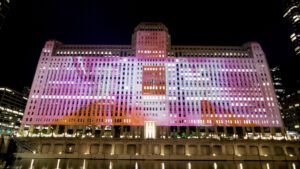
ideaXme interview with Cynthia Noble Executive Director, Vornado Arts and ART on THE MART
Neil Koenig, ideaXme board advisor: [00:00:00] Welcome to ideaXme. I’m Neil Koenig.
ART on THE MART
Neil Koenig, ideaXme board advisor: [00:00:04] Public art has been a feature of many cities for centuries, and Chicago is no exception. But over recent years, the city has taken a step further with an ambitious outdoor digital art scheme involving projections onto a vast structure called THE MART. At one time the world’s largest building. The executive director of ART on THE MART is Cynthia Noble. I met Cynthia in Chicago, and I began by asking her to tell us more about herself and her background.
Cynthia Noble, Executive Director, ART on THE MART: [00:00:40] I come to ART on THE MART from an art history background, which I think is important to my own personal history, professional history, but also to the identity of the project itself. Because ART on THE MART has a very humanist approach. It’s certainly an art and technology project, but we really want to centre people. And I come out of museums primarily here in Chicago, New York, elsewhere, and so bring that sense of art history, the rigour of the discipline. But also, I’ve always had a great interest in how we can engage with art widely. And so, when I worked in museums, for example, I often took more of an engagement role, engagement, and education. And so, with the opportunity to work on the ART on THE MART project, it’s been a really nice culmination of, different threads in my life where I can you know, explore the kind of conceptual rigour with an artist and a piece at the same time, know that it’s going to reach many people that wouldn’t normally have encounters with art. Since this project is outdoors, free, and accessible to all as a public art project, and so it’s a delightful culmination.
Neil Koenig, ideaXme board advisor: [00:02:02] Going back to the start of your career. I think, didn’t you originally want to be a lawyer?
CYNTHIA NOBLE, EXECUTIVE DIRECTOR ART on THE MART
Cynthia Noble, Executive Director, ART on THE MART: [00:02:08] I did, as an undergraduate. I was studying international relations and had spent time in South America. I was thinking very much about law as a means of understanding the exchange of cultures. and then I stumbled upon a particular book. It was a survey book of art history in the school library, and it changed the course for me because I decided that the better lens for me to understand the world was going to be through art and culture. And I knew I very much wanted to be part of that international discourse in general. And this was the better trajectory for me.
Neil Koenig, ideaXme board advisor: [00:02:55] And were you interested in art as a child?
Cynthia Noble, Executive Director, ART on THE MART: [00:02:58] I made a lot of art as a child. My mother was quite creative. I was inspired by her, not in a professional sense, but in a very playful sense, which I think is delightful. And so, yes, I carry that spirit of playfulness and inspiration into a project like this, which is quite new in a lot of ways and a kind of entrepreneurial mentality.
Neil Koenig, ideaXme board advisor: [00:03:25] So you made the switch from studying law. How did you then move into the art world, the museum world?
Cynthia Noble, Executive Director, ART on THE MART: [00:03:34] Well, I had studied at the school of the Art Institute of Chicago. Chicago was one of the places where there was this older European, more traditional European model of an art academy within a museum. And so, it continued in a certain degree, to a degree to function that way during my time there. And it allowed for me to transition quite smoothly into the museum itself in a professional position in the education department, where I stayed for a number of years before I left for the Guggenheim in New York, ultimately made my way back to Chicago and, had some other adventures in the art world and found myself here at THE MART.
Neil Koenig, ideaXme board advisor: [00:04:15] The aim of the ideaXme series is to talk to people who are moving the human story forward. Is that something that Art can help us with?
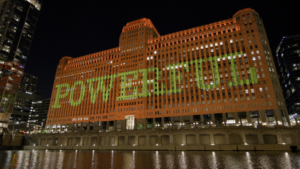
Cynthia Noble, Executive Director, ART on THE MART: [00:04:25] Absolutely. In fact, for me, it’s one of the principal ways we can move the story forward, because I think artists are in a contemporary in a culturally specific definition of artists taking a critical distance, an objective distance in a lot of ways from our contemporary conditions. And I think that critical distance is essential for the kinds of observations we need to make as a whole, as a collective and artists through those, through synthesising those observations, make proposals. I think of art projects, art installations, even resolved works as each as a kind of proposal. And I’ve always believed that, and I believe that even more so through my work with ART on the MART, because each time we install a projection on the facade of the Merchandise Mart, it’s an invitation for audiences to think, is this a way? Is this a way, a path forward? I think specifically of a work we did with the artist Nick Cave, who, really seductively invited people to view this very colourful, dynamic work on our facade that nonetheless addressed the difficult issues around racism, around some of the most poignant and pressing problems of our times and in presenting that, it very much felt like, it was removing, the patina of if you think of this building almost as a, as a monument, you know, there’s all this, of course, this discussion around monuments nowadays as well. And so, it was a way to instead of a patina which is associated with the past to be futuristic with the projection and with the concepts. And so not only with Nick Cave’s work, but with each work we place there. It’s an opportunity for us to think as a city, as a collective world about what can be, who we want to be.
CHICAGO’S LONG HISTORY OF PUBLIC ART
Neil Koenig, ideaXme board advisor: [00:06:35] There’s a long history of public art in cities around the world, and Chicago is no exception to that.
Cynthia Noble, Executive Director, ART on THE MART: [00:06:44] It’s more than not an exception. Chicago is really a leader in that regard, I would say, in public art in many people are familiar with the percent for Art fund in which when there’s some new development projects, a percentage of that goes toward installing public art. That originated here. Examples of that are the Alexander Calder sculpture in front of the Mies van der Rohe, (Ludwig Mies van der Rohe was a German American architect, academic, and interior designer) government building, etc. But even before mid-century monuments like that, we can look back to the late 19th century in Chicago. There was a man named by Benjamin Franklin Ferguson. There was the Ferguson Fund, which is now associated with the Art Institute, because some of the board members from the museum, collaborated on this fund and stewarded it. In any case, some of the representational public sculpture, public sculpture that you see, um, more of the traditional forms in equestrian form, those types came out of that effort in the late 19th century. And now while today those, look very historic and in certain cases can be problematic, nevertheless, they set the stage for a commitment to both place making and public art in our city.
Cynthia Noble, Executive Director, ART on THE MART: [00:07:59] And then there’s this other great moment, as I’ve already referenced in the mid-century where the Calder was installed, the Picasso was commissioned in Daley Plaza, which is a major civic centre here and, a Miro, etc.
Cynthia Noble, Executive Director, ART on THE MART: [00:08:15] We can look at another moment around, the turn of the millennium with the very famous Millennium Park. So, you have the, the Anish Kapoor, Cloud Gate, lovingly known as the Bean and also, the Crown Fountain, the Jaume Plensa Crown Fountain, etc. Beyond that, there have been the major installation of the Magdalena Abakanowicz, just south of Millennium Park. And so, when we came to envision ART on THE Mart, that was already about, 20 years or so approximately beyond that moment. And so, we really had this vision that we are already beginning to fulfil of ART on THE MART is really the next generation of public art in Chicago, being a digital project that’s agile, endemically because of its content and in terms of the scale, etc.
Neil Koenig, ideaXme board advisor: [00:09:09] Well, talking of scale, this building, the Merchandise Mart, I think, as it was originally called, is an extraordinary building. Tell us about it.
ART on THE MART IS LARGER THAN 2 AMERICAN FOOTBALL FIELDS
Cynthia Noble, Executive Director, ART on THE MART: [00:09:19] The facade we use, for example, is two and a half acres across. and for people more familiar with other kinds of measurements, that’s larger than two American football fields. So just to give you a benchmark. It once had its own zip code. The site, even before the building was constructed, is interesting in itself because we’re situated here at the confluence of the three branches of the Chicago River, and it was a trading post between the French and the indigenous people, the Potawatomi living here. Ultimately, when this this building was constructed on the Potawatomi land, it became a warehouse for the famous Marshall Field department store. It was built in 1930 by Graham, Anderson, Probst and White. So, a very renowned firm here in Chicago. And that was part of the Renaissance after the Chicago Fire, a good 50, 60 years earlier in 1871. In any case, built in this wonderful Art Deco style and was immediately a landmark in the Chicago urban scape and beyond that, it was then subsequently purchased by the Kennedy family, the political family here in the US. And then in the 90s, it was, um, purchased by Vornado Realty Trust, in New York. And through all its incarnations and ownership, it’s always maintained a kind of mission, which is to house design. So, both contract and residential design showrooms and as times have evolved, also it’s a great centre for technology. And so, in the interior, what this building houses is really it’s the nexus of art, design and technology. And so, it makes perfect sense that what we do on the exterior mirrors that.
Neil Koenig, ideaXme board advisor: [00:11:08] So how did this project come about? Was this your idea?
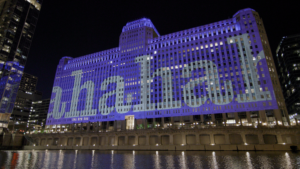
Cynthia Noble, Executive Director, ART on THE MART: [00:11:12] Oh, I can’t take credit for the idea. This was a project of many great mind, that was inspired by the development of the Riverwalk itself. So, there’s a Riverwalk that runs across the Chicago River from THE MART building, where you can promenade and enjoy a drink, take in ART on THE MART, and so forth. And as that project was being developed, it was an important concept for how Chicagoans ourselves think about our city. There was our gaze has always been toward the lake, particularly since the Daniel Burnham Plan in the late 19th century, when the land along the lakefront was reserved, unlike other Great Lakes cities and preserved in a natural way, so that we have these wonderful beaches right adjacent to our city. And as industry occurred and the river wasn’t cared for as it could have been in many years, our gaze again was toward the lake. So this project of the Riverwalk, was the idea of former Mayor Emanuel and others to think about how can we really consider this river corridor as yet another asset of Chicago? And so once the Riverwalk was nearly complete, there was a lighting framework plan for the city. The original vision was to light up not just THE MART, but many of the buildings along the river corridor. And some do to a certain extent, though not in the quite the way we’re how we’re playing. It coincided also with a public art plan for the city of Chicago that involved many, many civic stakeholders, including just lay citizens. And so that kind of synergy of events, prompted the mart to step forward and want to be a pioneer in doing something great for the city by really highlighting the asset of the river and, and creating a place to convene ourselves and all our visitors internationally and domestically to Chicago.
Neil Koenig, ideaXme board advisor: [00:13:12] Well, it’s easy to understand if you’ve got this riverside walk and these dramatic buildings, that you might want to light them up, perhaps son et lumière style, like in Europe. But it’s quite another thing to say. well, let’s go a little bit further and actually project some art onto this big space. So how did that idea come about?
Cynthia Noble, Executive Director, ART on THE MART: [00:13:35] There were challenges early on in the project, to build consensus amongst all of the different stakeholders about what this project could be. And as you can imagine, there were differences of opinion. Just some questions were: Should we go for, the kind of short win of the content that a lighting festival might provide that sense of spectacle? Or can we think about this in a longer-term way and in a more substantial way? There was there were naysayers initially, as always, when people are thinking about an ambitious project and luckily, you know, there was great trust and a risk that THE MART was willing to take. The parent company of Vornado and the city of Chicago itself to champion this vision, which has ultimately distinguished this project because, again, focusing on art that stands on its own legs apart from the technology and I think the technology is a very obviously essential, important part of the project, but it’s not what drives the content. We very much think about the technology as a tool versus, the end goal. It’s a means to a different kind of end. And going back to your good question about, you know, furthering our story, and technology is certainly part of our story, but it needs to, in my opinion, serve some other purposes.
Neil Koenig, ideaXme board advisor: [00:15:13] How did, artists react when this idea of emerged, of having a screen that’s two and a half acres size? I mean, one wonders what a medieval painter might have thought being confronted with something like that.
Cynthia Noble, Executive Director, ART on THE MART: [00:15:29] This is a bit of a stretch, but I think it does help to clarify in a certain sense I see it as a new medium because it has its own creative parameters. You know, the windows are subbed out in this video mapping project. Light does not permeate the windows, by the way. So, the people in the interior are not troubled by that, but what results is that you have all of these pockets, the windows of negative space in an image. You also have the strange, surface geometry. It’s not just a rectangle, the way we envision a screen. It’s got the towers on each end and the central tower. So, we have this interesting surface geometry and the material of the building itself, which is an Indiana limestone, absorbs colour in a quite interesting way. And so those are just some examples of creative parameters, plus the scale that artists needed to contend with. Artists first reactions were extreme. They were either all in or they were very risk averse. So, some artists that were risk averse clearly wanted to protect the reputation. What was this going to be? No one quite knew, not only because of the quote unquote new medium, but also because, there was an uncertainty about what the curatorial program might be.
DIANE THATER at ART on THE MART
Cynthia Noble, Executive Director, ART on THE MART: [00:16:52] And of course, artists want to insert themselves in a way that makes sense for their own paths. And I respect that. And so, it took a moment. So, we went with the risk takers. And I’m forever grateful to Diana Thater, for one, and some others who were part of the inaugural program back in September of 2018, who were willing to take the risk with us and make it up as we went along. She did wonderful work for us and so now we’re five years in and, to use a business analogy, I think we have proof of concept. And in a certain way, now we’re really getting started because we have built the trust of artists. It’s, a project that people want to participate in. I think artists are understanding, it is an opportunity to play in a way that they don’t have otherwise. Again, with scale, there are things like, how do you deal with pacing? How do you deal with changes in perspective and spatial treatments and a lot of formal concerns that probably ultimately influence other aspects of their practice across media. But this is a great chance to experiment.
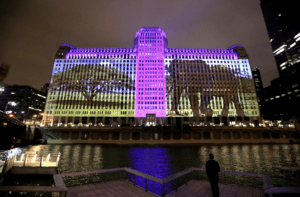
Digital video projection on existing architecture
Installation view, Merchandise Mart, Chicago, Illinois.
Sound by T. Kelly Mason.
Neil Koenig, ideaXme board advisor: [00:18:05] Can you pick out a couple of examples that you’re particularly proud of over the past five years?
Cynthia Noble, Executive Director, ART on THE MART: [00:18:12] I think often about the work that Charles Atlas offered us. It was a piece called Geometry of Thought that premiered in 2019. Charles Atlas, a pioneer in dance videography, dance, film especially worked with Merce Cunningham and now certainly has a reputation of his own that’s quite estimable. And Charles really understood that this is a screen, and yet it’s more than a screen because the architectural form of the building, it’s an object, a site-specific object that the artist thought about in that way, in a very site-specific way. So, he maximised the technology and in the video mapping sense of using the vertical, the positive verticals of the building very advantageously, the horizontal registers at the bottom, very advantageously. At the same time, the content, the subject matter of what he created has that, um, critical conceptual rigour. And in fact, when people ask me, what do you in the team look for in an artist? I referenced Charlie, and I say he’s a kind of unicorn because he merges that conceptual rigour with, the curiosity about the technology and the site specificity of, of this platform. Another work I loved. I’d like to mention, too, because our curatorial vision really does have these two elements. You know, we’re working with artists of that international regard, like Charles Ellis. At the same time, we’re tapping into Chicago’s arts and culture ecosystem. And so, we had a brilliant work by a team including Wills Glasspiegel, who produced a work called Footnotes that brought the footwork dance style that originated in Chicago to the world. So, we’re both bringing the world to Chicago and in a sense, bringing Chicago to the world. And that’s Chicago. It’s a globally positioned city that we want to honour.
Neil Koenig, ideaXme board advisor: [00:20:14] One of the other artists that recently you featured was Derrick Adams.
Cynthia Noble, Executive Director, ART on THE MART: [00:20:19] Yes, Derrick Adams and his studio, a delight to work with, created a piece called Funtime Unicorn that was very playful and yet so smart at the same time. And Derrick had a sense of really deferential to this idea of bringing of creating a museum outside of museum walls. It’s a phrase we’ve now talked about for decades, but he really explored that idea, did it so well in terms of his engagement and connection with people. He also demonstrated the power of mentorship. I saw how he worked with the younger people in his studio, and so it was quite experimental in a lot of ways, because of his processes. And then we saw a beautiful result to that debuted in spring of last year.
Neil Koenig, ideaXme board advisor: [00:21:07] And what have you got coming up?
Cynthia Noble, Executive Director, ART on THE MART: [00:21:09] In spring of this year? We always kick off in April of each year and run for nine months, nightly. We are kicking off with the artist Nora Turato, who is Croatian but has been based in Amsterdam now for some time. I think we’re lucky to work with her at this moment in her career where she’s, she’s about to really take off in the US. I know many people in Europe know her work well. She comes out of graphic design and performance, and yet she’s willing to take this risk and create this video that’s rooted in her really brilliant, witty, performances that are critiques of our culture of optimism and optimisation, better said. This idea that, you know, we’re always trying to perfect ourselves, whether that’s through, you know, yoga, meditation, mindfulness, work productivity, etc. She’s a very keen, a keen observer that that kind of artist that does take that critical distance and brings it home for us in a way that allows us to think about, you know, this as a proposal and how do we want to evolve as a culture?
Neil Koenig, ideaXme board advisor: [00:22:46] And who else is on the program this year?
Cynthia Noble, Executive Director, ART on THE MART: [00:22:48] In the summer, we’re going to feature Cory Arcangel, who’s a pioneer in video, video art. So, honoured to be working with him. And he’s creating a new commission for us. Also in the summer, we’re featuring a work by the Nigerian British artist Yinka Ilori. And I love Yinka’s work because it really hovers over art and design together, dissolves those boundaries. Which makes sense for again, for who we are at THE MART, a building of art, design, and technology and that will debut in alignment with NeoCon, a major, show here for the trade and public visits. It’s a major design show in June. Toward the fall, we’re working with the Poetry Foundation, a national organisation that happens to be based in Chicago, in a wonderful partnership that’s going to feature the poet laureate, Natasha Trethewey, whom we’ve commissioned a poem, and we’re pairing her with visual artist Bethany Collins in an exciting collaboration to do the visuals for the facade itself. At that same time, we are also working with an artist, Brendan Fernandes, who is going to be a separate artwork, but nice pairing juxtaposition with the Poetry Foundation. And we’ll round out the year with a partnership with the school of the Art Institute of Chicago. We think it’s important to also work with students and invest in invest in younger talent, as we know that this is a very content hungry platform.
Neil Koenig, ideaXme board advisor: [00:24:20] Nora Turato is an artist who works not just visually, but also with sound. Yes, and sound is actually a big part of this project, isn’t it?
Cynthia Noble, Executive Director, ART on THE MART: [00:24:32] Yes, we do have an audio component. So, when you’re viewing art on the march from the Riverwalk, we have a permanent audio speakers installed all along that section of the Riverwalk, so that the total work of art is actually the visual, plus the audio and in a certain sense, an immersive experience. So, Nora’s piece will be her performing the piece through the audio, and there will be her designed visuals, of course, on the facade. So, it’s a wonderful, fast paced, dynamic piece that will leave you scratching your head and wondering about a lot of things. It’s going to be fantastic to stir it up.
Neil Koenig, ideaXme board advisor: [00:25:14] How did audiences react?
Cynthia Noble, Executive Director, ART on THE MART: [00:25:17] Oh, one of my greatest pleasures in my whole life, really, was the inaugural opening in on September 29th, 2018. It was an incredibly tense time in Chicago and around the world, particularly around some racial tensions. It was it was a time in Chicago, a very politicised trial was happening that had to do with police brutality, and we didn’t know if it made sense, even at the time, to bring people together. What, would that be like? Or, and would people even be willing to, to come out when there were these pressing concerns? And I had spent an earlier portion of the evening on the Riverwalk, and at one point, which was quite crowded, and at one point I ascended the staircase to Wacker Drive, which is the street just above the Riverwalk. And I didn’t know the number at the time, but encountered 32,000 people, which was stunning. And I was literally it’s cliche, but was literally moved to tears because it meant to me that this art was important to people and that the compressed timeline that we drove, you know, all of 2018, that it had been worth it, that in a way, those of us that are engaged in the arts and culture world, you know, we’re often in a position of having to advocate for what we do.
Cynthia Noble, Executive Director, ART on THE MART: [00:26:43] Unfortunately, in some places it’s still not accepted as a basic need in the same way that other basic needs are. And I view it very much as a basic need and so to have a moment like that, where, where all of that advocacy was not necessary, that it was that it was a given that we needed to be here together. We needed to be here to experience these incredible inaugural artworks that could catalyse dialogue. And I see that very much as part of the mission of this project, that what we’re proposing, again, if we think of these as proposals or propositions, can do that. They can catalyse peaceful and constructive dialogue. They can convene us. And at the time, we didn’t even know how important convening pre-pandemic was. And so that’s taken on another layer of import in 2024. So, audiences have continued to be loyal. We’ve done audience surveys where we know many people are coming back. And yet at the same time, we were building new audiences worldwide, both those that attend physically and we have an extensive digital audience. So, the project, has its roots here, but is quite international at this point. And it’s delightful to see.
Neil Koenig, ideaXme board advisor: [00:28:01] A former colleague of mine at the BBC once wrote a piece about 20 years ago about how lots of buildings around the world seem to be turning into video screens. Is that a phenomenon you recognise?
Cynthia Noble, Executive Director, ART on THE MART: [00:28:13] Yes, I think there have been several stages in this proliferation of video in our urban landscapes particularly. And first we see it where the screens are in a way add-ons to existing architecture within the built environment. And then, then there’s this kind of intermediary stage where there have been some interventions. A midnight moment in New York’s Times Square is a good example of that, where the screens are dedicated three minutes a night to non-commercial content. So, there’s a kind of interesting disruption there. And this is occurring also in with Circa in Piccadilly with Piccadilly Lights in London also I believe, a three-minute pause in commercial advertising. And now we’re starting to see developers even adding intentionally adding screens to new buildings that they’re planning to utilise not only for commercial content, but also or sometimes not commercial content at all. But for works of video art. And I think the question you’re raising is the fundamental question right now for those of us in the field and for the public, for developers, for architects, for urban planners, for the public, for anyone who cares about cities. We have these screens. So, if the medium is the message, what do we want to say? And how are we curating these screens? Who gets to curate them? And yeah, what does that what does that look like? Those are the key questions that I’m living right now.
Neil Koenig, ideaXme board advisor: [00:29:45] And what are the answers? What do you hope for? What’s your hope for your project over the next five, ten years?
Cynthia Noble, Executive Director, ART on THE MART: [00:29:51] Well, for this project, we have a, you know, embedded into the public private agreement. We have the mart has an agreement with the city of Chicago to do this for at least 30 years. So, it’s a long-term project. And embedded in that agreement is that we will never use logos, branding, or messages on the facade. So, there’s that commitment. So, it will always be dedicated to public art. And I’d like to see us move toward a balance in our cities, a thoughtful balance between, revenue generating projects and projects that may not be at least at least in the short run. I think we need to look at other kinds of ROI. We need to look at the returns on investment that are about building community. And that’s of course, good for business, too, right? When you have thriving communities that are bolstered by thriving arts and culture scenes, they’re great places for thriving businesses. So, it all goes hand in hand. And so we are in a moment, somewhat post-pandemic, where we’re thinking about future cities, we’re thinking about how we want to live, and there’s a measure of rebuilding. I think we could all agree required to have the kind of animated cities full of life that we can each remember not so long ago. And so, I think media architecture, which is what I’ve been starting to call this field and I’m not I haven’t coined that word, but I like that phrase, media architecture. There’s a real opportunity to have content that substantial, that helps to convene people that is a different kind of placemaking that brings what has previously seemed like, stakeholders in dynamic tension together. So, I mean, the business community, I mean arts and culture and government, because I think we all need to be in dialogue around what our future cities will be.
Neil Koenig, ideaXme board advisor: [00:31:51] Cynthia Noble, thank you very much.
Cynthia Noble, Executive Director, ART on THE MART: [00:31:54] Thank you, as well. What a pleasure!
Interview credit: Neil Koenig, former BBC Producer and now ideaXme board advisor.
If you enjoyed this interview check out our discussion with Curator, Marcello Dantas.
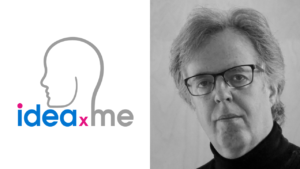
Neil Koenig: LinkedIn https://www.linkedin.com/in/neilkoenig/
ideaXme links:
Connect with the founder, Andrea Macdonald.
ideaXme is a global network – podcast on 12 platforms, 40 countries, mentor programme and creator series. Mission: To Move the human story forward™. Our passion: Rich Connectedness™!

